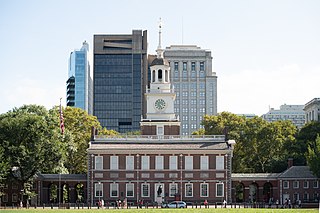Related Research Articles
The National Register of Historic Places (NRHP) is the United States federal government's official list of districts, sites, buildings, structures and objects deemed worthy of preservation for their historical significance or "great artistic value". A property listed in the National Register, or located within a National Register Historic District, may qualify for tax incentives derived from the total value of expenses incurred in preserving the property.

The National Trust for Historic Preservation is a privately funded, nonprofit organization based in Washington, D.C., that works in the field of historic preservation in the United States. The member-supported organization was founded in 1949 by congressional charter to support the preservation of America’s diverse historic buildings, neighborhoods, and heritage through its programs, resources, and advocacy.

The National Park Service (NPS) is an agency of the United States federal government headquartered at the Main Interior Building in Washington, D.C., that manages all national parks, most national monuments, and other natural, historical, and recreational properties with various title designations. The United States Congress created the agency on August 25, 1916, through the National Park Service Organic Act.

A National Historic Landmark (NHL) is a building, district, object, site, or structure that is officially recognized by the United States government for its outstanding historical significance. Only some 2,500 (~3%) of over 90,000 places listed on the country's National Register of Historic Places are recognized as National Historic Landmarks.

Historic preservation (US), built heritage preservation or built heritage conservation (UK), is an endeavor that seeks to preserve, conserve and protect buildings, objects, landscapes or other artifacts of historical significance. It is a philosophical concept that became popular in the twentieth century, which maintains that cities as products of centuries’ development should be obligated to protect their patrimonial legacy. The term refers specifically to the preservation of the built environment, and not to preservation of, for example, primeval forests or wilderness.

The National Historic Preservation Act is legislation intended to preserve historic and archaeological sites in the United States of America. The act created the National Register of Historic Places, the list of National Historic Landmarks, and the State Historic Preservation Offices.

The National Film Preservation Foundation (NFPF) is an independent, nonprofit organization created by the U.S. Congress to help save America's film heritage. Growing from a national planning effort led by the Library of Congress, the NFPF began operations in 1997. It supports activities nationwide that preserve American films and improve film access for study, education, and exhibition. The NFPF's top priority is saving orphan films, so called because are not protected by commercial interests and are unlikely to survive without public support. Through its grant programs, the NFPF has helped archives, historical societies, libraries, museums, and universities from all 50 states preserve American films and make them available to the public.
The American Battlefield Trust is a charitable organization whose primary focus is in the preservation of battlefields of the American Civil War, the Revolutionary War and the War of 1812 through acquisition of battlefield land. The American Battlefield Trust was formerly known as the Civil War Trust. On May 8, 2018, the organization announced the creation of the American Battlefield Trust as the umbrella organization for two divisions, the Civil War Trust and the Revolutionary War Trust, which was formerly known as "Campaign 1776."

The Texas Historical Commission is an agency dedicated to historic preservation within the state of Texas. It administers the National Register of Historic Places for sites in Texas.

Save America's Treasures is a United States federal government initiative to preserve and protect historic buildings, arts, and published works. It is a public–private partnership between the U.S. National Park Service and the National Trust for Historic Preservation. The National Endowment for the Arts, National Endowment for the Humanities, and Institute of Museum and Library Services are also partners in the work. In the early years of the program, Heritage Preservation and the National Park Foundation were also involved.

The New Jersey Historic Trust was created by the State of New Jersey in 1967 to preserve New Jersey's historic resources. The Historic Trust's executive director is Dorothy P. Guzzo.

Save Outdoor Sculpture! (SOS!) was a community-based effort to identify, document, and conserve outdoor sculpture in the United States. The program was initiated in 1989 and ended in 1999.

The Jay Heritage Center (JHC) is a 501(c)(3) not-for-profit organization incorporated in 1990 and chartered by the New York State Board of Regents to act as stewards of the 23-acre Jay Estate, the National Historic Landmark home of American Founding Father John Jay. Jay's ancestral property in Rye, New York is considered the centerpiece of the Boston Post Road Historic District.

The Underwater Archaeology Branch (UAB) of the Naval History & Heritage Command (NHHC) is a unit of the United States Department of the Navy. It was formally founded in 1996 as a consequence of the emerging need to manage, study, conserve, and curate the U.S. Navy's submerged cultural resources.

Save Our Heritage Organisation (SOHO) is a non-profit organization devoted to the preservation of the historic architecture and landmarks around the San Diego, California area. Founded in 1969, Save Our Heritage Organisation maintains several historic buildings including the Whaley House and the George W. Marston House. They are directly partnered with the National Trust for Historic Preservation.
Baltimore Heritage is an American nonprofit historic-preservation organization headquartered in Baltimore, Maryland.
Save Ontario Shipwrecks (SOS) is a Provincial Heritage Organization in Ontario, Canada. SOS is a public charitable organization which operates through Local Chapter Committees supported by a Provincial Board of Directors and Provincial Executive.
Demond "Brent" Leggs is an African American architectural historian and preservationist from Paducah, Kentucky. Among his roles at the National Trust for Historic Preservation he has been the founding director of the African American Cultural Heritage Action Fund, with the goal of raising $25,000,000 to protect and preserve African American history via material culture and beyond.

The practice of preserving the battlefields of the American Civil War for historical and memorial reasons has been developed over more than 150 years in the United States. Even during the American Civil War active duty soldiers on both sides of the conflict began erecting impromptu battlefield monuments to their recently fallen comrades. Since these initial attempts at preservation and commemoration, important Civil War battle sites have been preserved by various groups and many are now in the care of the National Park Service and overseen by the American Battlefield Protection Program (ABPP). Of approximately 10,500 acts of aggression that occurred between the United States and the Confederacy 384 have been identified in a 1993 federal report as being principle to the conflict. From these a select few have been chosen based on their historical significance, accessibility, and preservability to be federally curated. Beyond sites run by the U.S. Federal government many secondary battle sites across the United States are maintained and operated by state governments and private historical groups.
The African American Cultural Heritage Action Fund is a program formed in 2017 to aid stewards of Black cultural sites throughout the nation in preserving both physical landmarks, their material collections and associated narratives. It was organized under the auspices of the National Trust for Historic Preservation. The initiative which awards grants to select applicants and advocates of Black history has been led by architectural historian Brent Leggs since 2019. It is the largest program in America to preserve places associated with Black history.
References
- Save Our History, The History Channel